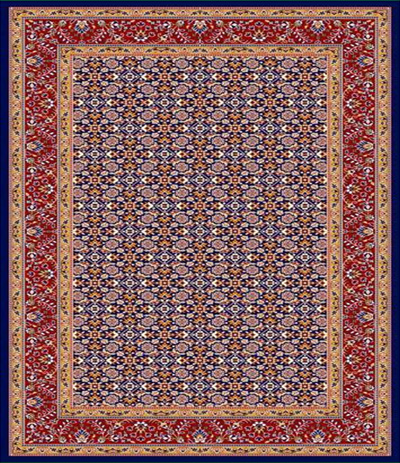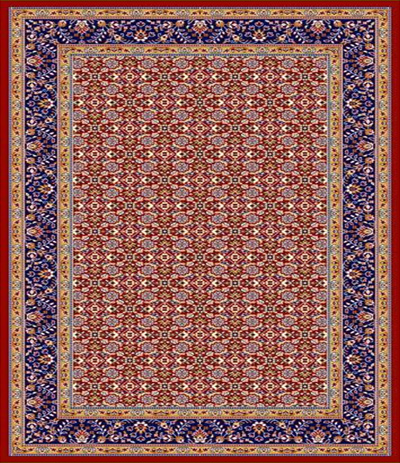Carpets from Karnal, a city steeped in textile tradition, are revered for their exceptional craftsmanship and distinctive artistic flair. Handcrafted by skilled weavers who blend centuries-old techniques with contemporary influences, Karnal carpets showcase a harmonious fusion of cultural motifs and intricate patterns.
Made predominantly from locally sourced wool, these carpets are known for their luxurious texture, resilience, and vibrant hues that remain vivid over time. Each carpet is a testament to meticulous attention to detail, with designs ranging from ornate floral arrangements to geometric symmetries, reflecting the diverse artistic heritage of the region.
Karnal carpets are prized not only for their aesthetic appeal but also for their practicality, offering warmth and acoustic insulation to any space they adorn. Their versatility makes them a favored choice for enhancing the ambiance of homes, offices, and hospitality venues around the globe.
Beyond their functional attributes, Karnal carpets embody a cultural legacy passed down through generations of artisans who continue to uphold traditional craftsmanship. The weaving process itself is a labor of love, requiring patience and precision to achieve the intricate patterns and fine textures that define these exquisite floor coverings.
In today's global market, Karnal carpets remain a symbol of India's rich textile heritage, sought after by collectors and interior designers who appreciate their timeless beauty and enduring quality. Whether displayed as decorative masterpieces or used for practical purposes, carpets from Karnal continue to captivate and inspire with their timeless elegance and artisanal excellence.
Karnal carpets encompass a variety of types, each distinguished by its unique design elements, weaving techniques, and cultural influences. Here are some prominent types of Karnal carpets:
1. Persian-Inspired Carpets: These carpets often feature intricate floral patterns, central medallions, and borders influenced by traditional Persian designs. They are characterized by rich colors and meticulous detailing, reflecting a blend of Persian and local artistic sensibilities.
2. Geometric Patterned Carpets: Known for their symmetrical designs and geometric motifs, these carpets often incorporate squares, diamonds, or hexagonal shapes. The patterns can range from simple repeating geometries to more complex arrangements that create visual depth and interest.
3. Floral Motif Carpets: These carpets showcase elaborate floral designs, including blossoms, vines, and leaves intricately woven into the fabric. Floral motifs are a hallmark of Indian carpet weaving and are often combined with borders and central medallions for a balanced composition.
4. Silk Carpets: While wool is the primary material used in Karnal carpets, silk carpets are also crafted for their luxurious texture and sheen. Silk carpets from Karnal feature fine weaving techniques that enhance the brilliance of colors and the intricacy of designs, making them prized for their elegance and craftsmanship.
5. Modern Designs: In response to contemporary tastes, Karnal carpet weavers also produce carpets with modern designs that cater to current interior décor trends. These may include abstract patterns, minimalist compositions, or fusion designs that blend traditional elements with contemporary aesthetics.
6. Dhurries: Dhurries are flat-woven carpets traditionally made from cotton or wool. They are lightweight and versatile, used as floor coverings, mats, or even wall hangings. Dhurries from Karnal often feature simple geometric patterns or stripes in vibrant colors, suitable for both indoor and outdoor settings.
Each type of Karnal carpet reflects the region's rich heritage of craftsmanship and artistic expression, offering a wide range of options to suit different tastes and preferences in home décor and interior design.
The raw materials used in Karnal carpets primarily include natural fibers such as wool and occasionally silk. These materials are sourced locally or from nearby regions known for their quality wool production. Here’s a breakdown of the raw materials typically used:
1. Wool: Wool is the most common and traditional raw material used in Karnal carpets. It is sourced from sheep reared in the surrounding regions, including parts of Haryana and neighboring states. Wool is favored for its durability, resilience, and ability to hold vibrant colors.
2. Silk: Silk is used in some Karnal carpets, particularly in finer, more luxurious pieces. Silk fibers are prized for their smooth texture, lustrous sheen, and ability to enhance intricate designs. Silk carpets from Karnal often exhibit exceptional craftsmanship and are considered premium products.
3. Cotton: While less common in traditional hand-knotted carpets, cotton is used in flat-woven carpets known as dhurries. Dhurries are lighter and more practical for everyday use, often woven with cotton yarns for their durability and affordability.
4. Natural Dyes: Alongside raw materials, natural dyes play a crucial role in the production of Karnal carpets. These dyes are derived from plants, minerals, and insects, creating a palette of colors that range from earthy tones to vibrant hues. Natural dyes not only enhance the aesthetic appeal of the carpets but also contribute to their eco-friendly and sustainable qualities.
The combination of these raw materials and natural dyes ensures that Karnal carpets maintain their traditional charm, durability, and aesthetic richness, appealing to both domestic and international markets seeking quality craftsmanship and cultural authenticity.
Karnal carpets, known for their craftsmanship and cultural significance, are available in a variety of sizes to suit different needs and preferences. While sizes can vary based on individual preferences and specific orders, there are several standard sizes that are popular among buyers and collectors:
1. Small Sizes:
- 2 ft x 3 ft: These smaller sizes are often used as accent rugs or decorative pieces in smaller areas such as entryways, bathrooms, or beside beds.
- 3 ft x 5 ft: Slightly larger than the smallest sizes, these carpets are versatile and can be used in various spaces including living rooms and dining areas.
2. Medium Sizes:
- 4 ft x 6 ft: This size is popular for medium-sized rooms or as focal points in living areas. It provides enough coverage to define a seating area or to be placed under a coffee table.
- 5 ft x 8 ft: A common size that works well in living rooms and larger spaces. It can anchor furniture arrangements and add warmth and style to the room.
3. Large Sizes:
- 8 ft x 10 ft: A popular size for larger rooms such as dining rooms or master bedrooms. It offers substantial coverage while complementing the overall decor of the space.
- 9 ft x 12 ft: This size is often chosen for spacious rooms and grand settings. It provides ample coverage and enhances the elegance of the room.
4. Runners:
- 2.5 ft x 6 ft: Runners are long and narrow carpets used primarily in hallways, entryways, or along corridors. They add visual interest and can help define pathways in a home.
5. Custom Sizes:
- Beyond standard sizes, Karnal carpets are also made to order in custom sizes to fit specific dimensions and requirements. This flexibility allows buyers to tailor their carpets to perfectly suit their spaces and design preferences.
These sizes cater to various needs—from accent pieces to room-defining carpets—reflecting the versatility and craftsmanship that Karnal carpets are known for. Whether used in residential homes, hotels, or commercial spaces, Karnal carpets continue to be cherished for their beauty, quality, and cultural heritage.
Karnal carpets are esteemed for their exquisite craftsmanship and rich cultural heritage, originating from the city of Karnal in Haryana, India. Handcrafted by skilled artisans using traditional weaving techniques passed down through generations, these carpets embody a blend of artistic finesse and meticulous attention to detail.
Made primarily from high-quality wool sourced from local sheep, Karnal carpets are known for their durability, soft texture, and vibrant colors that withstand the test of time. The designs of Karnal carpets often feature intricate patterns inspired by Persian, Mughal, and local motifs, showcasing a harmonious fusion of artistic influences.
Each Karnal carpet is a labor of love, reflecting the artisan's dedication to preserving centuries-old traditions and craftsmanship. Whether adorned with floral motifs, geometric patterns, or elaborate medallions, these carpets not only enhance the aesthetic appeal of any space but also serve as cultural artifacts that tell a story of India's rich textile heritage.
Highly sought after for their elegance and authenticity, Karnal carpets adorn homes, offices, and hotels worldwide, bringing warmth, beauty, and a touch of timeless craftsmanship to every environment they grace.
















